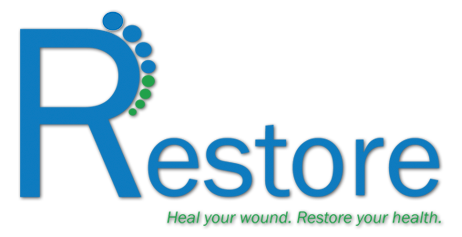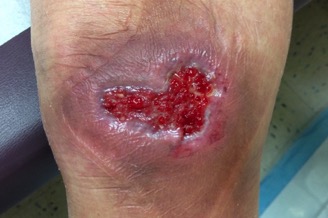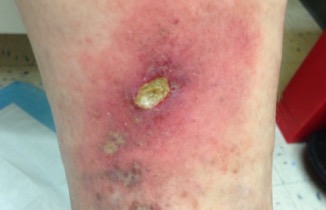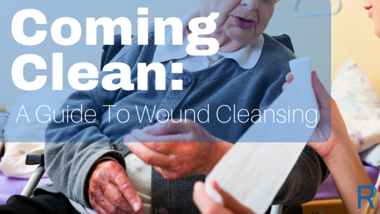
Every day in our wound clinic there is one topic that comes up in many different forms: How do I clean my wound? What do I clean it with? Do I really HAVE to clean my wound?
There are many ways for patients and caregivers to cleanse a wound – and a few important ways to NOT cleanse a wound.
NOTE: we are referring to cleansing a wound or how to “wash” it
– as opposed to cleaning a wound –
which is more inclusive of things like debridement or removal of unwanted tissue.
Why do we cleanse a wound in the first place?
Our goals are to provide a healthy wound environment for new cells to grow, to reduce bacteria in and around a wound, and to prevent infection that would slow or stop the wound from healing.
Every wound has bacteria in it, whether it looks healthy or unhealthy:
Both wounds below need to be cleansed to promote and maintain a healthy environment for progress to occur.
[/kc_column_text][/kc_column][/kc_row]
This wound looks healthy, with red vibrant new tissue in the middle and new skin at the edges.

This wound looks unhealthy, with yellow debris in the middle and red inflammation around it.

WHEN do we cleanse a wound?
- When the wound occurs or when it is discovered, it is VERY important to clean it thoroughly. At this point, the goal is to remove any bacteria or foreign debris, not to promote new cell growth. If you do not have any saline solution or cleansing agents, use plenty of soap and water, to flush out the wound.
- At prescribed dressing changes: cleanse the wound when changing the dressing as advised by your health care clinician. You do not want to apply a new dressing without cleansing the wound. You want to come clean! Remove the old drainage and the byproducts of the drainage combined with the dressing. Do not be worried: a wound WILL smell prior to the dressing change. Just think if you did not shower for a few days or a week: you will smell! After showering, you smell good. Give your wound the same courtesy!
- If the dressing gets contaminated: Occasionally a dressing covering a wound will get wet or soiled. It is very important to remove the dressing, clean the wound as instructed, and then replace the dressing. It is a good practice to talk with your wound care provider and ask them what to do if this occurs (especially if you have specialty dressings).
WITH WHAT do we clean a wound?
This is the million-dollar question! There are many many choices for cleansing wounds. Antiseptics, Antibiotics, Anti-bacterial Soap, Wound Cleansers, Skin Cleansers, Saline, and tap water. How does one choose?
In general, we want a cleanser that is not toxic to healthy tissue, that is readily available, and that is not too costly. Here is a quick review of the main options:
Traditional Wound Cleansers: RECOMMENDED
- Normal saline solution: this is preferred because it is not harmful to healthy tissue, it comes in many sizes, and is easy to obtain.
- Wound cleansers: these are detergent cleansers that use a surfactant to attach to the bacteria and assist in its removal. They are often in a convenient spray bottle. There are several wound products that may be affected by their use, however.
- Potable (drinkable) water: This is recommended in the absence of saline or another cleanser. Some studies have shown similar effectiveness to normal saline solution in reducing bacteria.
Antiseptics:
- Hydrogen Peroxide: it is commonly used as a wound antiseptic for a filthy wound, but its use is NOT recommended as a routine wound cleanser. The bubbling effect may assist in loosening debris, but some studies have shown it to be cytotoxic to healthy cells. It is NOT recommended in wounds with sinus tracts (or areas one cannot see).
- Povidone iodine: this is a broad spectrum antimicrobial solution that can kill bacteria, but it can also be cytotoxic to healthy tissue. The solution is also very drying and there are a significant amount of people allergic or irritated to iodine. It is NOT recommended for regular cleansing for wounds.
- Sodium Hypochlorite (Dakin’s solution): this is an antibacterial solution that can be used for short-term time frames to kill bacteria, loosen dead tissue, and reduce odor. It can be cytotoxic to healthy cells in certain concentrations, however.
- PHMB: broad-spectrum antimicrobial agent; used in many oral and ophthalmic settings. Recent safe addition to many wound products.
- HOCl (Hypochlorous Acid): an emerging solution in wound care that shows good potential in effectively reducing bacteria and biofilms without harming viable tissue.
Wounds: 2014; 26(12):342-350
Skin Cleansers and Soaps:
- Skin Cleansers: Used for cleaning of skin, especially for fecal material. NOT recommended for wounds.
- Soaps: Certain soaps have been found to be very toxic to viable tissue, such as Dial Antibacterial, Ivory Liqui-gel, and Dove Moisturizing Body Wash. They are NOT recommended as wound cleansers.
Advances in Skin & Wound Care: September 2005: Volume 18, Issue 7: pp 373-378.
HOW do we clean a wound?
While our goals are to remove bacteria, we also want to make sure we do not cause trauma to the wound or drive bacteria further into it. Methods that are used to irrigate wounds include: showering, spray bottles, whirlpools, pulsed lavage, pouring a solution over a wound, soaking, and applying a solution to a gauze and mechanically cleaning the surface. Here we will just cover ways that patients and caregivers can clean wounds.
- First of all, WASH your hands and PUT ON GLOVES. These two simple steps will greatly reduce the transfer of bacteria to a wound.
- Secondly, use only slight pressure of an irrigant toward the wound bed. Safe pressure to clean a wound without harming the bed has been determined to be 4-15psi (pounds per square inch). Most spray cleansers will deliver this psi, loosening the debris without driving bacteria into wound cavities or tissue.
- Showering over a wound is very helpful for most wounds. Be careful, however, to avoid powerful jets directly on the wound. Also, do not shower with a foot wound if it means standing in the contaminated water in a poorly draining tub. (For you outdoor enthusiasts: isn’t it nicer to drink from a running stream than a stagnant pond? Give your wound the same advantage.) After the shower, don some gloves, rinse off the wound and apply the new bandage.
- In general, it is NOT recommended to soak a wound. While we never say never, we will go out on a limb and say NEVER soak a diabetic foot wound. (Pun intended). Not only will many diabetics not feel the water temperature due to effects of peripheral neuropathy, but also soaking will allow bacteria from other areas to travel to the wound. It will also deteriorate the skin by drying it out.
No matter which option of cleansing you choose; please consult with your wound care clinicians for their input on what is best for your wound.
 As the magical Joe Maddon advises: Embrace the Target! Our target has been to clean up the murky subject of Wound Cleansing. I know this topic can be very confusing: hopefully you’ve gotten a bit of clarity and we’ve gotten a bullseye!
As the magical Joe Maddon advises: Embrace the Target! Our target has been to clean up the murky subject of Wound Cleansing. I know this topic can be very confusing: hopefully you’ve gotten a bit of clarity and we’ve gotten a bullseye!

This blog post was written by Robin Carlson, PT CWS
What is PT CWS? Physical Therapist and Certified Wound Specialist




 As the magical Joe Maddon advises: Embrace the Target! Our target has been to clean up the murky subject of Wound Cleansing. I know this topic can be very confusing: hopefully you’ve gotten a bit of clarity and we’ve gotten a bullseye!
As the magical Joe Maddon advises: Embrace the Target! Our target has been to clean up the murky subject of Wound Cleansing. I know this topic can be very confusing: hopefully you’ve gotten a bit of clarity and we’ve gotten a bullseye!
